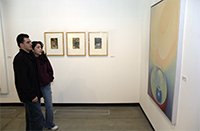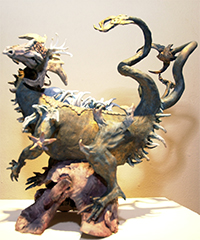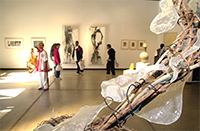The Art of Teaching Art
Professors showcase their creativity, talent in faculty exhibition
By NATHAN HATHAWAY / The Collegian

JOSEPH HOLLAK / The Collegian
(Above) Visiting the gallery on a date, graduate student Juan Vieyra and girlfriend Norma Valle said they were impressed with the exhibit; (1.Below) “Emnectur,” by Linda Richmond, is on display at the Phoebe Conley Art Gallery; (2. Below) Fresno Unified students visit the gallery on a class trip. |
Art is all about conveying a message. Political, social, ideological, aesthetic.
And the pieces on display during the exhibition of faculty artwork and designs are no different.
The exhibition, in the Conley Art Gallery until Monday, showcases mostly artwork from faculty in the art department.
The media exhibited in the show range from sculptures to photos to paintings, to the downright off-beat.
“The Delirium of Difference,” a mixed-media piece by Melissa Delaney, uses many random items put together into a piece that points out the “homogeneity of human ethnic groups,” as stated on a sign explaining the piece.
The sign explains that scientists are finding evidence that all humans share 99.9 percent of the same genetic coding, and there appear to be more differences between individuals of the same race than between individuals of different races. Delaney points out that culture and race are becoming obsolete concepts, that society marginalizes “various ethnicities in the arena of culture.”
 “The Delirium of Difference” is composed of hundreds of lines of monofilament, representing strands of DNA, that fall from a piece of plexiglass suspended horizontally from the ceiling. Coin-sized mirrors are placed randomly within the monofilament, representing various markers on the DNA strands. These strands extend all the way to the floor, where a slab of plexiglass with letters representing the nucleotide proteins written on it lies over a map of the world. A spotlight shines down on the piece. “The Delirium of Difference” is composed of hundreds of lines of monofilament, representing strands of DNA, that fall from a piece of plexiglass suspended horizontally from the ceiling. Coin-sized mirrors are placed randomly within the monofilament, representing various markers on the DNA strands. These strands extend all the way to the floor, where a slab of plexiglass with letters representing the nucleotide proteins written on it lies over a map of the world. A spotlight shines down on the piece.
“The piece addresses cultural constructions of meaning using text and visual metaphor,” Delaney writes.
The artist’s explanation paints the piece as Delaney fulfilling a social responsibility to shed light on cultural and racial identity.
“As new corporate, political and societal boundaries are being drawn up at a rapid pace, science provokes art to once again challenge the urge to categorize society based on external markers of diversity,” Delaney writes.
A piece titled “Ocula Interrupta” uses a video projector and two small chain-link fence gates with thick paper woven through the links. Human faces are screen printed on this paper, and a silent video of close-ups of various people’s faces. The gates are rotating counterclockwise, driven by a small motor, and a projector screen is behind the rotating gates.
A new age instrumental soundtrack accompanies the piece.
“Surrealism challenged us to see beyond the expected. Photography has shown us reflection and double exposure. Cinema pushed our imagination. How much more can we know? How much more can we know? My art intends to challenge the viewer to see more.”
 Nick Potter took the opportunity the faculty show provided to make a statement about the current war in Iraq. Nick Potter took the opportunity the faculty show provided to make a statement about the current war in Iraq.
Potter’s mixed-media piece, titled “Before the Rain,” is a photo of Baghdad before the conflict began and has Arabic writing superimposed over it.
Potter said the text over the photo, which was translated for him by a friend in Florida and is a compendium of various texts Potter chose for the piece.
He said the translation reads “Before the destruction, a house, a street, a capital. Through the doors of bitter ashes, the silent and deadly emptiness far away from reality.”
“I used the text primarily because, visually, how it would look,” Potter said, “but also the text is kind of important, as well.
“It’s a difficult situation we’re in, and that’s why that phrase ‘through the doors of bitter ashes.’ Once we’re in there, we’re going to have to deal with the repercussions.”
|
